World Journal of Condensed Matter Physics
Vol.2 No.2(2012), Article ID:19087,5 pages DOI:10.4236/wjcmp.2012.22011
The Effect of Antimony Substitution on the Magnetic and Structural Properties of Fe0.75–xSi0.25Sbx Alloys
![]()
1Department of Physics, Sultan Qaboos University, Muscat, Sultanate of Oman; 2Department of Physics, Cochin University of Science and Technology, Cochin, India.
Email: *ialomari@squ.edu.om, ialomari@yahoo.com
Received December 28th, 2011; revised February 8th, 2012; accepted February 25th, 2012
Keywords: Lattice Constant; Curie Temperature; Saturation Magnetization
ABSTRACT
The results of the investigation of the magnetic and structural properties of the alloy system Fe0.75–xSi0.25Sbx, where x = 0, 0.05, 0.1, 0.15, 0.2, and 0.25 synthesized by mechanical alloying followed by heat treatment are described. The x-ray diffraction reveals that all samples crystallize in the DO3-type cubic phase structure. Substituting Fe by Sb led to a decrease in the lattice constant and the unit cell volume. The magnetic properties are investigated by vibrating sample magnetometer and show that all the samples are ferromagnetically ordered at room temperature. The Curie temperature is found to decrease linearly from (850 ± 5) K for the parent alloy to (620 ± 5) K for the alloyith x = 0.25. The saturation magnetizations at room temperature and at 100 K are found to decrease with increasing the antimony concentration. The above results indicate that Sb dissolves in the cubic structure of this alloy system.
1. Introduction
Intermetallic compounds Fe3X (X = Al, Si, Ge) are fascinating group of materials, which have recently attracted much attention from the viewpoint of fundamentals as well as application. This class of materials with the ordered phase at elevated temperatures (T > 800 K) has promising mechanical and corrosion properties both in the microcrystalline and nanocrystalline states [1-4]. Ternary element additions to these systems have been used to improve the high temperature strength and other physical properties. At present, numerous experimental data are available on the ordered and disordered Fe3Si and Fe3Al alloy systems, because of their high temperature strength, excellent oxidation and corrosion resistance. Substitution of Fe by a transition metal element affects the magnetic properties, the lattice parameter, and the structural ordering of these alloys [5-12]. Waliszewski et al. [12] studied the Fe3–xCrxSi system and found that the Curie temperature decreases from 840 K for x = 0 to 712 K for x = 0.4, and the magnetic moment of iron at the B site to be 2.44 μB, and about 1.18 μB for (A, C) sites, while the magnetic moments of Cr were determined to be (2.03 ± 1.3) μB for Cr at the B site and (0.41 ± 0.63) μB for the (A, C) sites with orientation antiparallel to the magnetic moments of Fe.
The structural and magnetic properties of the intermetallic Fe-Si alloys depend on the Si concentration. FeSi2 was found to form the tetragonal type structure, FeSi forms the B20 type structure, while Fe3Si forms the DO3 type cubic structure. Fe3Si is a well ordered ferromagnetic alloy with four sites: 2-equivanlt sites (A, C) occupied by Fe and the other two sites are occupied by Fe (B site) and Si (D site) [13]. Fe1–xSix forms a continuous rage of solid solution with a bcc structure between x = 0 and 0.265 [14]. Mössbauer and NMR [15,16] investigations for this system have yielded information about the hyperfine field and Si site occupation. These studies showed that the hyperfine field and the magnetic moment at the Fe sites strongly depend on the Si occupancy and the number of Fe nearest neighbors and they decrease with increasing the Si concentration.
A recent study by Mantovan et al. [4] showed that Fe3Si thin film is a good candidate as ferromagnetic electrode in spintronics devices due to its high spin polarization and Curie temperature. Furthermore, the use of Fe3Si has been proposed for spin injection in semiconductors [17]. Antimony is widely used in alloying to increase hardness and mechanical strength. Many of Antimony compounds are also used in superconductors, Hall-effect devices, diodes, batteries cable sheathing, tartar emetic which has been used in medicine. Prakash et al. [18] studied the effect of antimony doping on the transport and magnetic properties of CeO0.9F0.1FeAs1−xSbx Superconductors and found that Sb increases the superconducting transition temperature (Tc) from 26 K for the parent compound with x = 0 to 43.17 K for x = 0.1. Antimony is the most effective additive to inhibit diffusional growth of particles. Dixon et al. [19] have shown that the addition of antimony to iron-in-mercury magnetic liquids forms a layer around the iron and reduces the growth of the nanoparticles which reduces the magnetization. The effect of antimony doping on magnetic properties of Ni-Zn ferrites was studied by Purnanandam et al. [20]. This study confirmed that the magnetic quality factor increases with increasing Sb percentage while the saturation magnetization and the Curie temperature decrease with increasing antimony doping in Ni-Zn ferrites.
In this paper we focused our attention on the synthesizes of the Fe0.75−xSi0.25Sbx alloy system by mechanical alloying followed by heat treatment for six different samples which allows us to investigate the effects of substituting ferromagnetic iron be diamagnetic antimony on the structural and magnetic properties of the Fe0.75−xSi0.25Sbx alloy system.
2. Samples Preparation and Experimental Procedures
Fe0.75−xSi0.25Sbx alloys (x = 0, 0.05, 0.10, 0.15, 0.2 and 0.25) were synthesized by mechanical alloying of high purity elemental Fe, Si, and Sb in a SPEX 8000 mixer/ mill for 15 hours using tungsten-carbide (WC) balls and WC vial. The ball to powder mass ratio was 3:1, and the milling was carried out under argon atmosphere. After the milling, the powder samples were annealed under vacuum in quartz ampoules for 24 hours at 800˚C, to ensure homogeneity. The ampoules were then rapidly quenched into cold water. Subsequent the samples were characterized by powder x-ray diffraction on a Philips diffractometer by using Cu-Ka radiation. The magnetic measurements were carried out in the temperature range 100 K ≤ T ≤ 975 K, using a Vibrating Sample Magnetometer (VSM) in magnetic fields up to 13.5 kOe.
3. Results and Discussion
Figure 1 shows the powder x-ray diffraction patterns for two representative samples of the alloy system Fe0.75−xSi0.25Sbx with x = 0.00, and 0.15. All the observed reflection lines obtained at room temperature for all investigated samples exhibit lines characteristic for the DO3-type structure. The indices for the various peaks are shown in the diffraction patterns of Figure 1. All the other samples studied have similar behavior with a shift in the peaks’ position. The patterns for each of the samples with x between 0.00 and 0.25 are consistent with a single phase of the cubic type with lattice parameter a = 5.652 Å for x = 0. The composition dependence of the lattice constant a on the Sb concentration are listed in Table 1. The lattice parameter is found to decrease linearly with increasing the Sb concentration from 5.652 Å for x = 0 to 5.630 Å for x = 0.25. The lattice parameter a = 5.652 Å for the parent alloy, with x = 0, is in good agreement with previous reported values of 5.653 Å by Cowdery and Kayser [21], and 5.650 Å by Yoon and Booth [11]. The decrease in the lattice parameter and hence the unit cell volume with increasing the Sb concentration is due to the volume contraction because of the smaller atomic radius of Sb (1.53 Å) compared with the atomic radius of Fe (1.72 Å). This behavior is in good agreement with previous reported observations for similar alloys by Shobaki et al. [22] for Fe0.7−xVxAl0.3 alloys and Al-Omari and Hamdeh for Fe0.7−xVxSi0.3 [23]. The linear decrease in the lattice parameter for these alloys as we increase the Sb concentration suggests a simple dilution process.
The magnetic field (H) dependence of the magnetization (M) for the different samples at room temperature and at low temperature, T = 100 K, is shown in Figures 2 and 3. It is clear from these figures that all the samples exhibit ferromagnetic behavior with soft magnetic properties, as no hysteresis observed in any of the samples. The saturation magnetization (Ms) for Fe0.75−xSi0.25Sbx alloys as a function of the antimony concentration (x), for
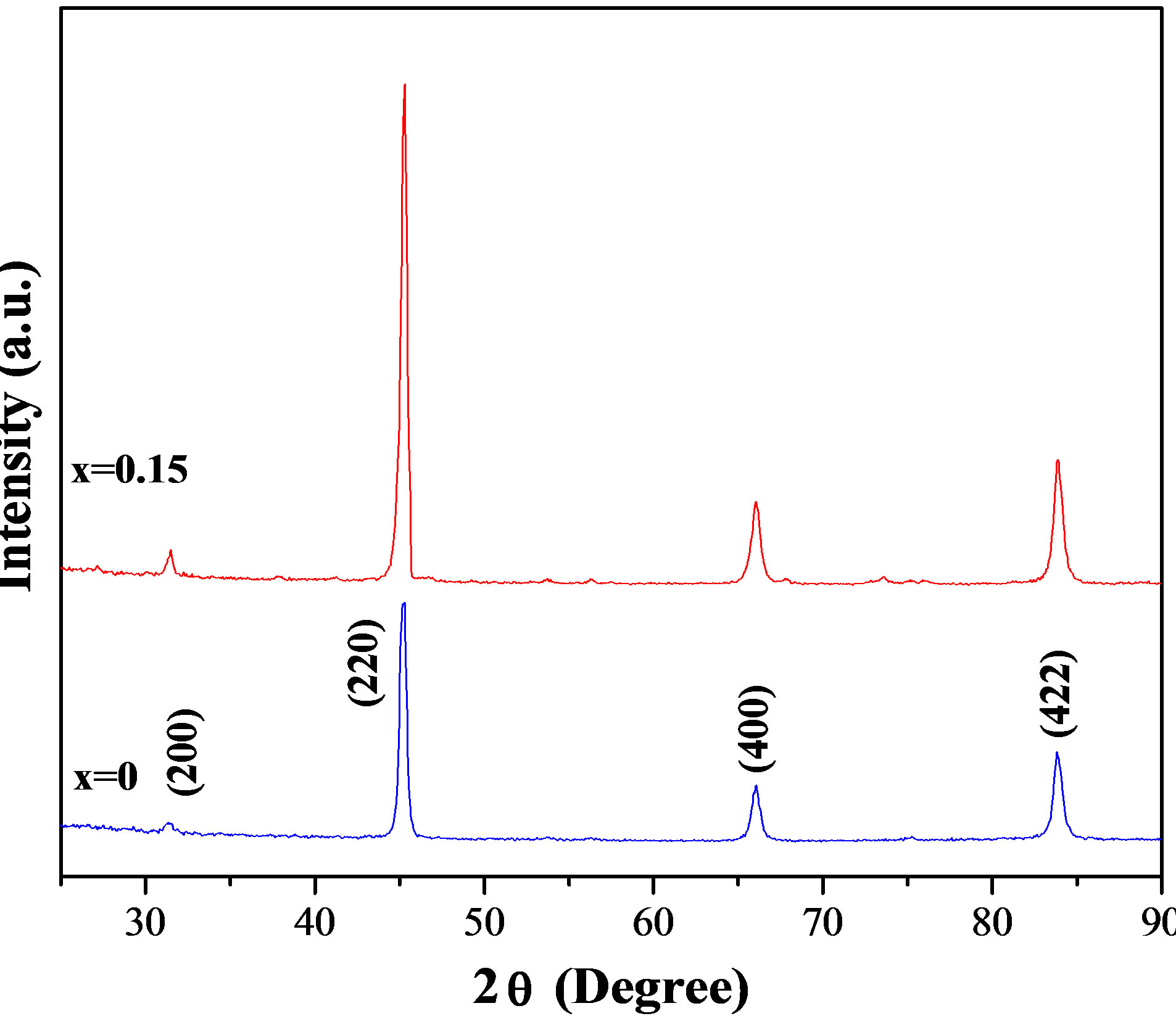
Figure 1. Typical x-ray diffraction pattern for two representative samples of the alloy system Fe0.75−xSi0.25Sbx.

Table 1. Dependence of the lattice constant (a) and the saturation magnetization at T = 0 K (found from the extrapolation) on the antimony concentration (x), for Fe0.75−xSi0.25Sbx alloys.
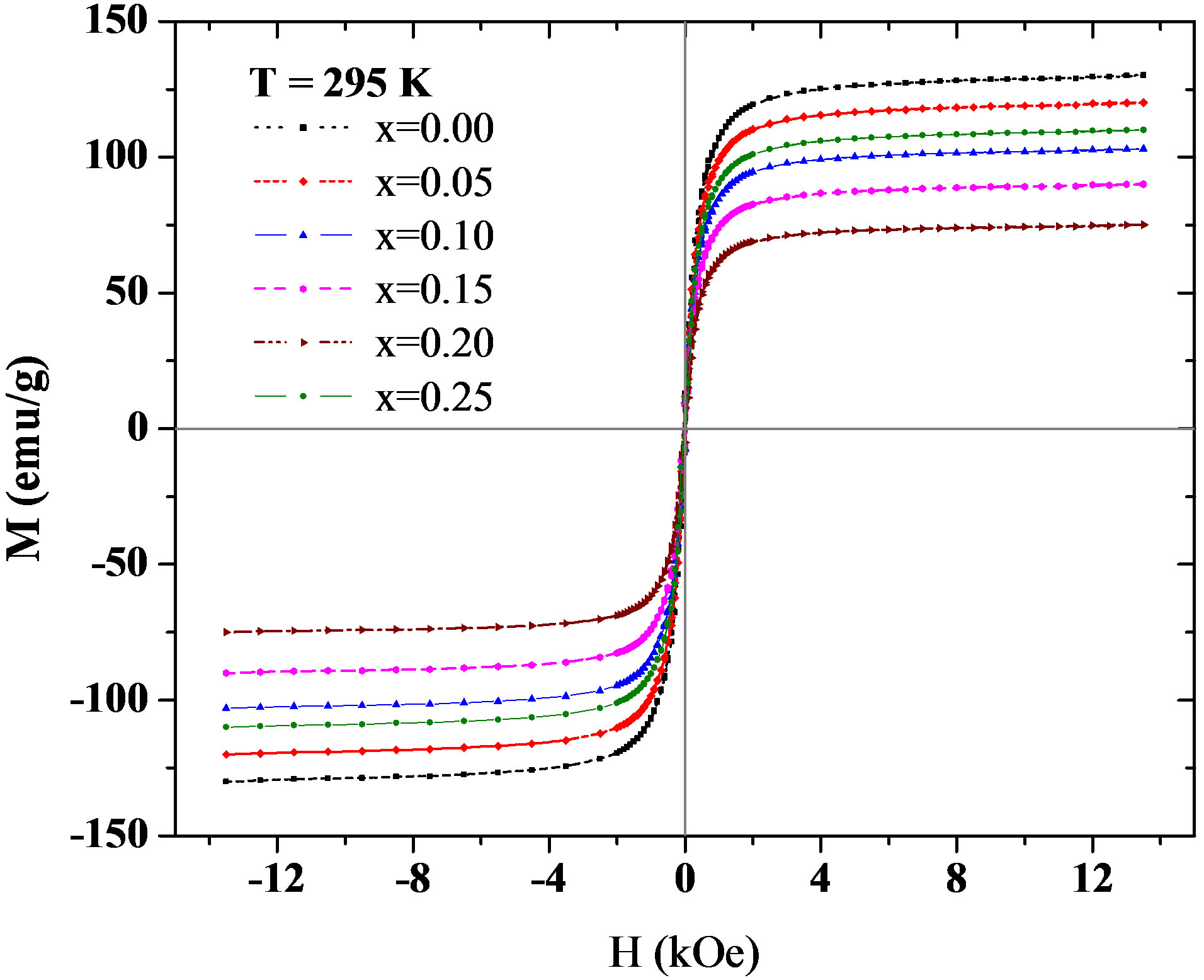
Figure 2. Magnetization curves for Fe0.75−xSi0.25Sbx alloys, at room temperature for different antimony concentrations (x).
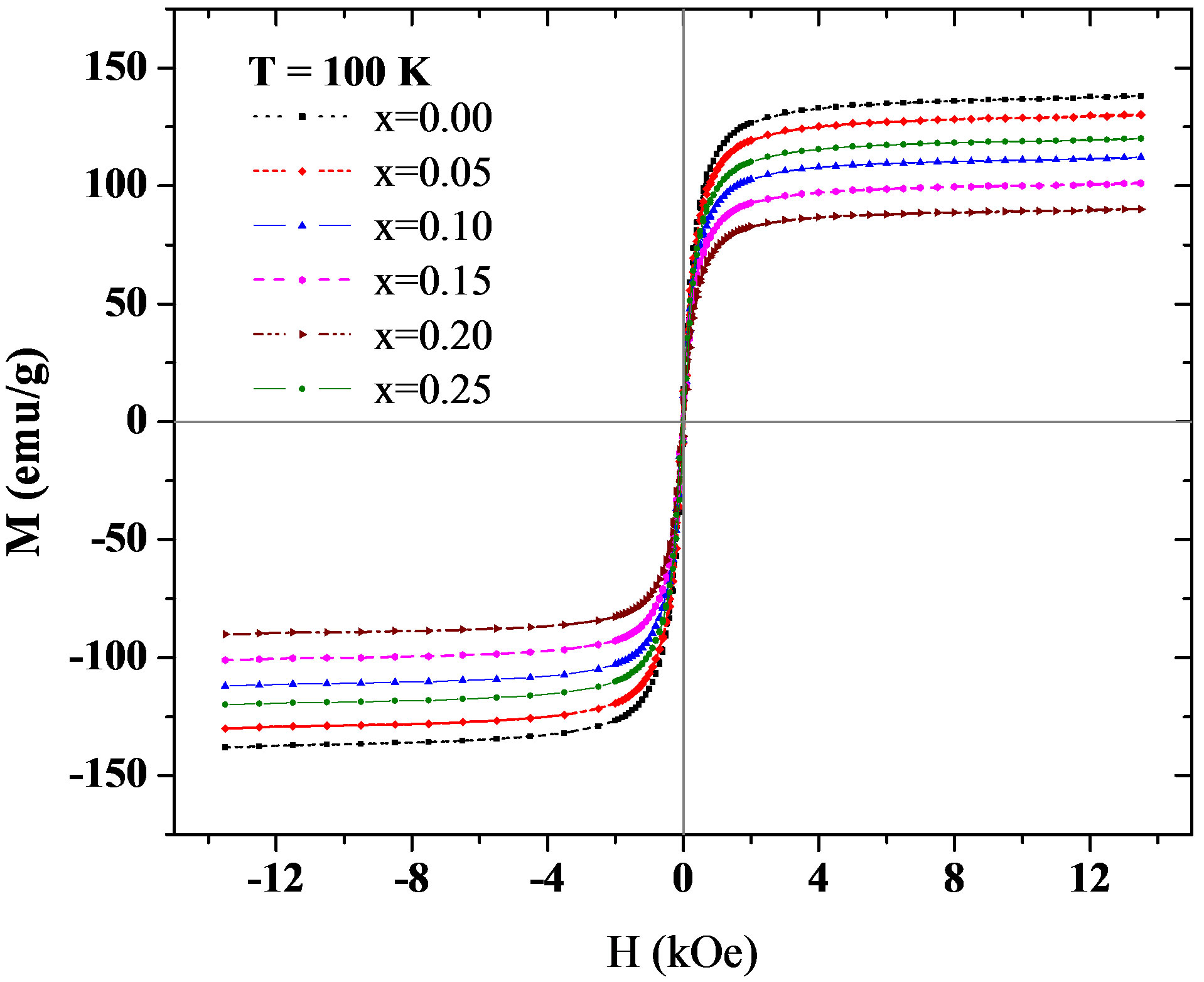
Figure 3. Magnetization curves for Fe0.75−xSi0.25Sbx alloys, at low temperature (T = 100 K) for different antimony concentrations (x).
the two temperatures T = 295 K and T = 100 K, is presented in Figure 4. As shown in this figure, Ms decreases with increasing the Sb concentration (x). This decrease is due to the replacement of ferromagnetic Fe by diamagnetic Sb in these alloys.
The temperature dependence of the magnetization for the different samples of the alloy system Fe0.75−xSi0.25Sbx under an applied magnetic field of 13.5 kOe is shown in Figure 5. It can be seen from this figure that all the samples studied have ferromagnetic ordering below Curie temperature (Tc) while the spontaneous magnetization decreases with increasing the Sb concentration (x). It is clear from Figure 5 that the magnetization increases with decreasing the temperature, as would be expected from a system with ferromagnetic coupling below Tc. This figure
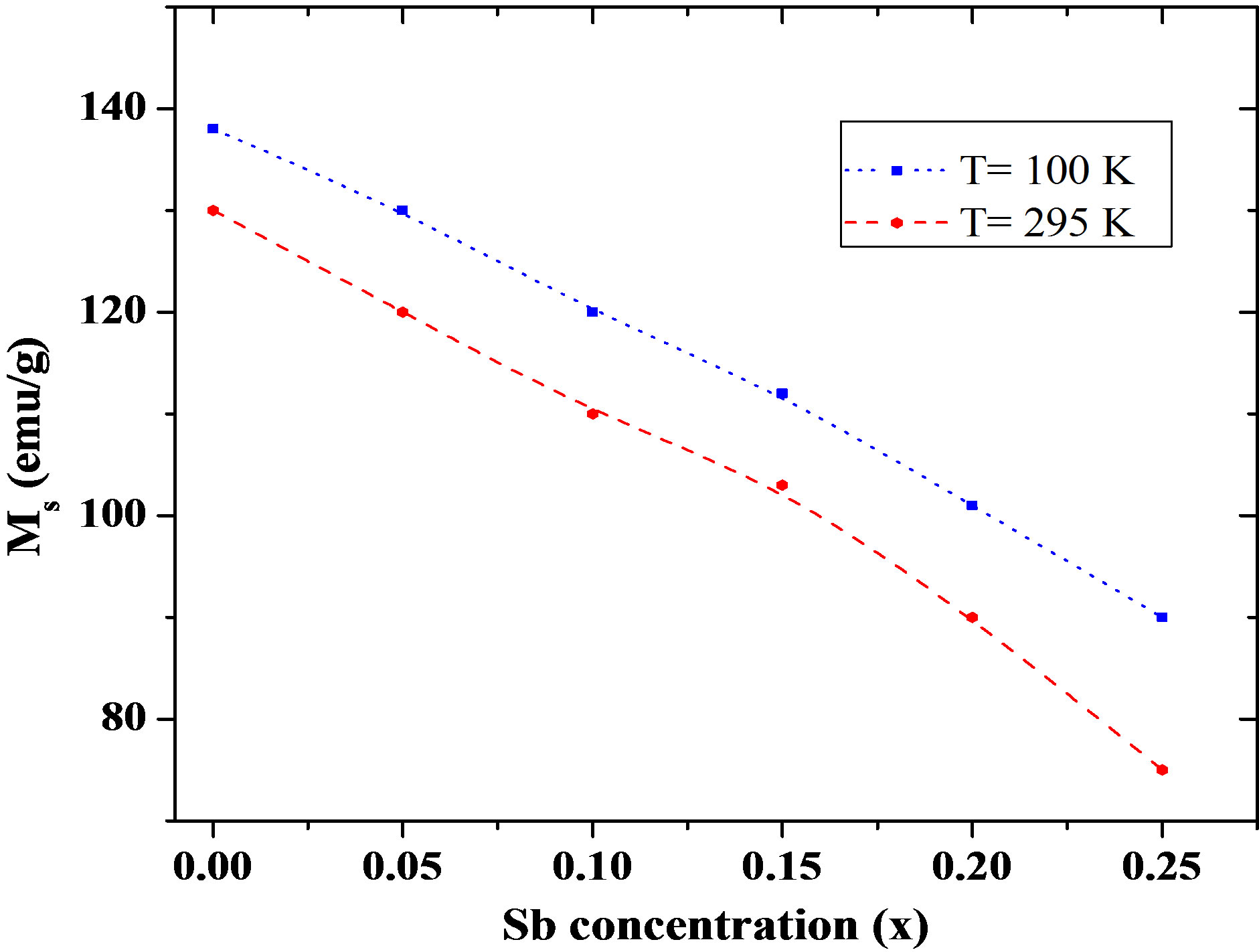
Figure 4. The saturation magnetization (Ms) as a function of the antimony concentration (x), at T = 295 K and T = 100 K, for Fe0.75−xSi0.25Sbx alloys.

Figure 5. Temperature dependence of the magnetization for the different samples of the alloy system Fe0.75−xSi0.25Sbx under an applied magnetic field of 13.5 kOe.
also shows that Ms tends to decrease linearly with decreasing the temperature far below Tc. This decrease is expected for a system with ferromagnetic coupling and in qualitative agreement with our observation of the magnetic hyperfine field from the Mössbauer measurements on a similar Fe0.7−xSi0.3Mnx alloy system [24].
Using the method of intersecting tangents for M versus T curves in Figure 5, we found that the Curie temperature Tc decreases linearly with increasing the antimony concentration and the results are shown in Figure 6. The Curie temperature of (850 ± 5) K for x = 0 is in agreement with other previously reported value of 840 K by Pugaczowa-Michalska et al. [25]. The decrease in Tc with increasing x can be attributed to the reduction of the exchange field interaction between the spins of the magnetic Fe atoms, which can be a result of the decrease of the number of magnetic atoms surrounding each iron atom upon increasing the Sb concentration.
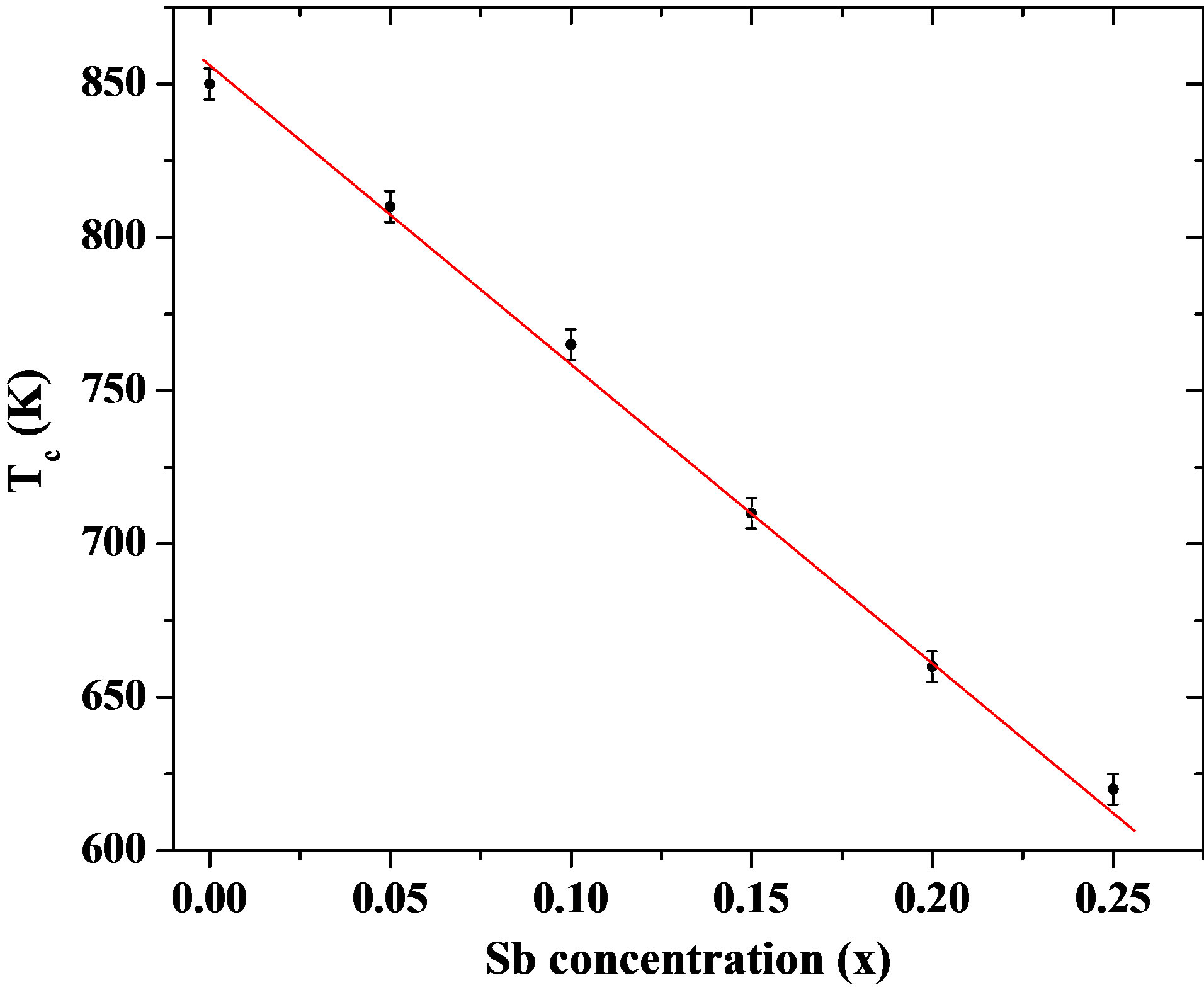
Figure 6. The Currie temperature (Tc) as a function of on the antimony concentration (x), for Fe0.75−xSi0.25Sbx alloys. The solid line represents a guide to the eye.
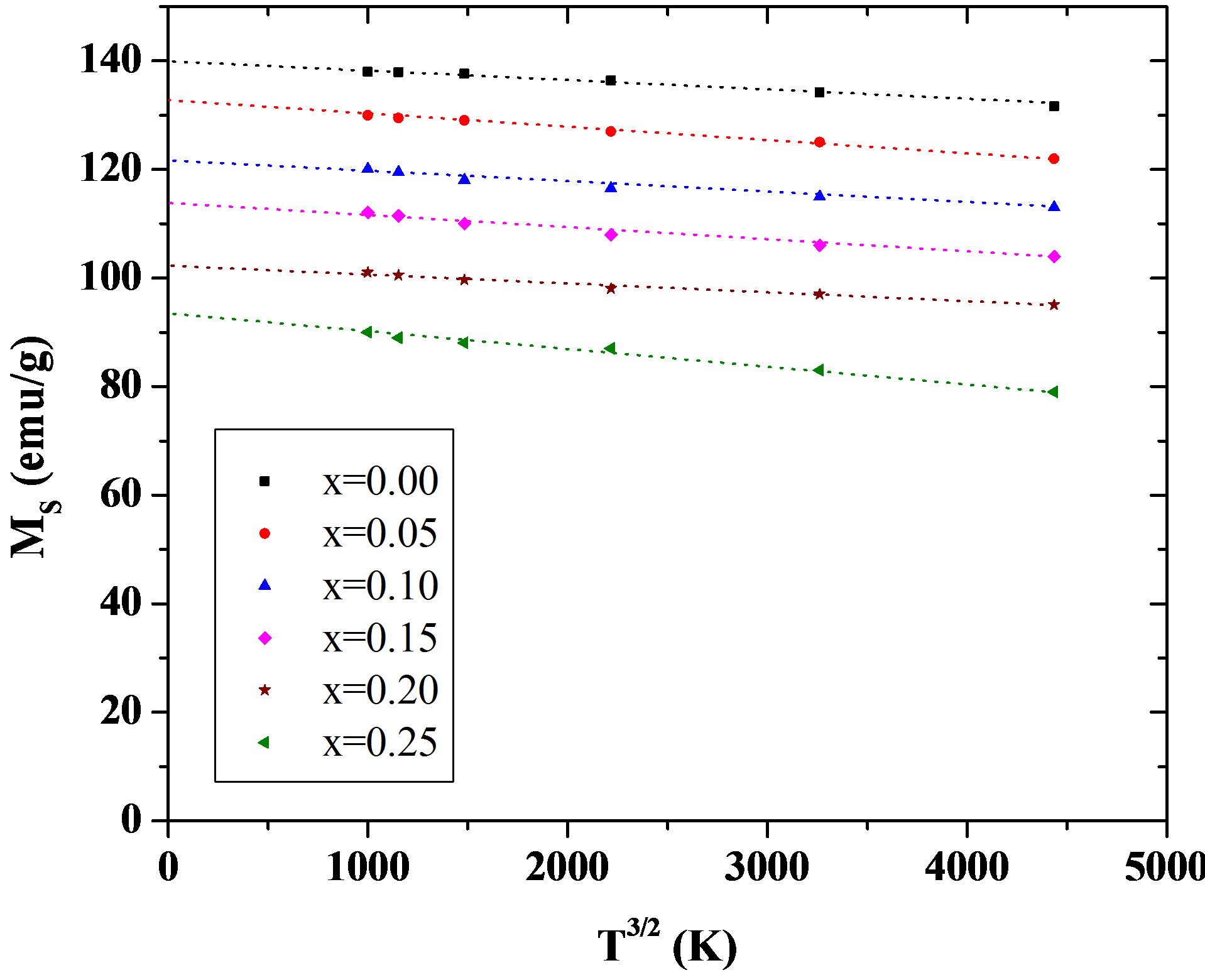
Figure 7. The saturation magnetization (Ms) as a function of T3/2 (at low temperatures, T ≤ 300 K), for Fe0.75−xSi0.25Sbx alloys. The solid lines represents a straight line extrapolated to T = 0.
Since the magnetization of all the samples saturates for temperatures at room temperature and below we plotted in Figure 7 the saturation magnetization as a function of T3/2 at low temperatures (T ≤ 300 K), where T is the temperature in Kelvin. This figure shows that Ms as a function of T3/2 obeys Bloch law at low temperatures, where by extrapolating Ms to T = 0 K we can estimate the saturation magnetization at that temperature, and the results are presented in table I for the different Sb concentrations. The decrease in Ms with increasing the antimony concentration, x, is due to the decrease in the iron magnetic moment due to replacing magnetic Fe by diamagnetic Sb. The extrapolated saturation magnetization for Fe3Si at T = 0 K of (140 emu/g = 4.91 μB/f.u.) is in agreement with the calculated values of 5.1 μB/f.u. by PugaczowaMichalska et al. [25], 4.9 μB/f.u. by Kulikov et al. [26] and the experimental value of 4.7 μB/f.u. by Waliszewski et al. [12].
4. Conclusion
We have investigated the magnetic and structural properties of the alloy system Fe0.75−xSi0.25Sbx. Structural studies revealed the formation of the DO3-type cubic phase structure, with a decrease in the lattice constant and the unit cell volume upon substituting Fe by Sb. Magnetic measurements showed that all the samples have ferromagnetic behavior up to the Curie temperature, Tc. The obtained linear dependence of the lattice constant, Curie temperature, and the saturation magnetization at low temperatures on the antimony concentration indicate a simple dilute solution when Fe is substituted by Sb. All the results of the present work strongly suggest the reduction of the saturation magnetization with increasing x, which is due to the replacement of ferromagnetic Fe by diamagnetic Sb.
5. Acknowledgements
The authors are grateful to Sultan Qaboos University for the support provided to perform this study under the research grant number IG/SCI/PHYS/09/01.
REFERENCES
- S. Sarkar, C. Bansal and A. Chatterjee, “Gibbs-Thomson Effect in Nanocrystalline Fe-Ge,” Physical Review B, Vol. 62, No. 5, 2000, pp. 3218-3222. doi:10.1103/PhysRevB.62.3218
- Z. Q. Gao and B. Fultz, “Transient B32-Like Order during the Early Stages of Ordering in Undercooled Fe3Al,” Philosophical Magazine B, Vol. 67, No. 6, 1993, p. 787. doi:10.1080/13642819308219325
- S. Sarkar and C. Bansal, “Disorder-Order and Structural Phase Transformations in Nanocrystalline Fe3–xMnxGe Alloys Synthesized by Mechanical Alloying,” Journal of Alloys and Compounds, Vol. 366, No. 1-2, 2004, pp. 107- 119.
- R. Mantovan, M. Georgieva, M. Fanciulli, A. Goikhman, N. Barantcev, Yu. Lebedinskil and A. Zenkevich, “Synthesis and Characterization of Fe3Si/SiO2 Structures for Spintronics,” Physica Status Solidi (A), Vol. 205, No. 8, 2008, pp. 1753-1757.
- K. Ishikawa, R. Kainuma, I. Ohnuma, K. Aoki and K. Ishida, “Phase Stability of the X2AlTi (X: Fe, Co, Ni and Cu) Heusler and B2-Type Intermetallic Compounds,” Acta Materialia, Vol. 50, No. 9, 2002, pp. 2233-2243. doi:10.1016/S1359-6454(01)00434-7
- S. Suga, S. Imada, A. Yamasaki, S. Ueda, T. Muro and Y. Saitho, “X-MCD at Twin-Helical Undulator Beam Line BL25SU of Spring-8,” Journal of Magnetism and Magnetic Materials, Vol. 233, No. 1-2, 2001, pp. 60-64. doi:10.1016/S0304-8853(01)00228-1
- G. L. F. Fraga, P. Pureur and D. E. Brandao, “Spontaneous Magnetoimpedance in the Heusler Compounds Pd2MnSn and Pd2MnSb near the Curie Temperature,” Solid State Communications, Vol. 124, No. 1-2, 2002, pp. 7-10. doi:10.1016/S0038-1098(02)00476-3
- J. W. Dong, J. Lu, J. Q. Xie, L. C. Chen, R. D. James, S. Mckernan and C. J. palmstrom, “MBE Growth of Ferromagnetic Single Crystal Heusler Alloys on (0 0 1) Ga1–xInxAs,” Physica E, Vol. 10, No. 1-3, 2001, pp. 428- 432. doi:10.1016/S1386-9477(01)00131-X
- G. A. Al-Nawashi, S. H. Mahmood, A. D. Lehlooh and A. S. Saleh, “Mössbauer Spectroscopic Study of Order-Disorder Phenomena in Fe3−xMnxSi,” Physica B, Vol. 321, No. 1-4, 2002, pp. 167-172. doi:10.1016/S0921-4526(02)00845-1
- Y. Kobayashi, T. Kaneko, M. Kamogawa, K. Asai, K. Akiyama and H. Funakubo, “Structural Characterization by Electronic Transport Properties on Fe3Si Films,” Journal of Physics D: Applied Physics, Vol. 40, No. 22, 2007, pp. 6873-6878. doi:10.1088/0022-3727/40/22/003
- S. Yoon and J. Booth, “Magnetic Properties and Structures of Some Ordered (FeMn)3Si Alloys,” Journal of Physics F: Metal Physics, Vol. 7, No. 6, 1977, pp. 1079- 1095. doi:10.1088/0305-4608/7/6/022
- J. Waliszewski, L. Dobrzynski, A. Malinowski, D. Satula, K. Szmanski, W. Prandl, Th. Brückel and O. Schärpf, “Magnetic Moment Distribution in Fe3−xCrxSi Alloys,” Journal of Magnetism and Magnetic Materials, Vol. 132, No. 1-3, 1994, pp. 349-358. doi:10.1016/0304-8853(94)90331-X
- V. A. Niculescu, T. J. Burch and J. I. Budnick, “A Local Environment Description of Hyperfine Fields and Atomic Moments in Fe3−xTxSi Alloys,” Journal of Magnetism and Magnetic Materials, Vol. 39, No. 3, 1983, pp. 223-267. doi:10.1016/0304-8853(83)90084-7
- M. Hansen, “Constitution of Binary Alloys,” McGrawHill, New York, 1958.
- M. B. Stearns, “Internal Magnetic Fields, Isomer Shifts, and Relative Abundances of the Various Fe Sites in FeSi Alloys,” Physical Review, Vol. 129, No. 3, 1963, pp. 1136-1144. doi:10.1103/PhysRev.129.1136
- J. J. Budnick, S. Skalski, T. J. Burch and J. H. Wernick, “Hyperfine Fields in Fe-Si Alloys,” Journal of Applied Physics, Vol. 38, No. 3, 1967, pp. 1137-1138. doi:10.1063/1.1709514
- A. Ionescu, C. A. F. Vaz, T. Trypiniotis, C. M. Gütler, H. García-Miquel, J. A. C. Bland, M. E. Vickers, R. M. Dalgliesh, S. Langridge, Y. Bugoslavsky, Y. Miyoshi, L. F. Cohen and K. R. A. Ziebeck, “Structural, Magnetic, Electronic, and Spin Transport Properties of Epitaxial Fe3Si/ GaAs(001),” Physical Review B, Vol. 71, No. 9, 2005, pp. 1-9. doi:10.1103/PhysRevB.71.094401
- J. Prakash, S. J. Singh, G. Thakur, S. Patnaik and A. K. Ganguli, “The Effect of Antimony Doping on the Transport and Magnetic Properties of Ce(O/F)FeAs,” Superconductor Science and Technology, Vol. 24, No. 12, 2011, Article ID 125008. doi:10.1088/0953-2048/24/12/125008
- T. S. Dixon, S. W. Charles and J. Popplewell, “The Effect of the Addition of Antimony on the Physical and Magnetic Properties of Iron Particles in Mercury,” Journal of Physics F: Metal Physics, Vol. 11, No. 9, 1981, pp. 1931- 1941. doi:10.1088/0305-4608/11/9/022
- M. Purnanandam, T, Bhimasankaram and S. V. Suryanarayana, “Effect of Antimony Doping on Magnetic Properties of Ni-Zn Ferrites,” Journal of Materials Science, Vol. 26, No. 22, 1991, pp. 6131-6134. doi:10.1007/BF01113895
- S. Cowdery and F. Kayser, “Lattice Parameters of Ferromagnetic DO3-Structured Iron-Aluminum-Silicon Alloys,” Materials Research Bulletin, Vol. 14, No. 1, 1979, pp. 91- 99. doi:10.1016/0025-5408(79)90236-8
- J. Shobaki, I. A. Al-Omari, M. K. Hassan, B. A. Albiss, K. A. Azez, M.-Ali Al-Akhras, H. H. Hamdeh and S. H. Mahmood, “Mössbauer and Structural Studies of Fe0.7−xVxAl0.3 Alloys,” Journal of Magnetism and Magnetic Materials, Vol. 213, No. 1-2, 2000, pp. 51-55. doi:10.1016/S0304-8853(99)00621-6
- I. A. Al-Omari and H. H. Hamdeh, “Mössbauer and Structural Studies of Fe0.7−xVxSi0.3 Alloy System,” Physica Status Solidi (C), Vol. 1, No. 7, 2004, pp. 1809-1812.
- I. A. Al-Omari, A. Gismelseed, A. Rais, H. M. Widatallah, A. Al-Rawas, M. Elzain and A. A. Yousif, “Mössbauer Studies of Fe0.7−xSi0.3Mnx Alloys,” Hyperfine Interactions, Vol. 156-157, No. 1-4, 2004, pp. 123-127. doi:10.1023/B:HYPE.0000043233.23660.69
- M. Pugaczowa-Michalska, A. Go, L. Dobrzynski and S. Lipinski, “Electronic Structure and Magnetism of Fe3−xCrxSi Alloys,” Journal of Magnetism and Magnetic Materials, Vol. 256, No. 1-3, 2003, pp. 46-53. doi:10.1016/S0304-8853(02)00295-0
- N. I. Kulikov, D. Fristot, J. Hugel and A. V. Postnikov, “Interrelation between Structural Ordering and Magnetic Properties in bcc Fe-Si Alloys,” Physical Review B, Vol. 66, No. 1, 2002, Article ID 014206. doi:10.1103/PhysRevB.66.014206
NOTES
*Corresponding author.

